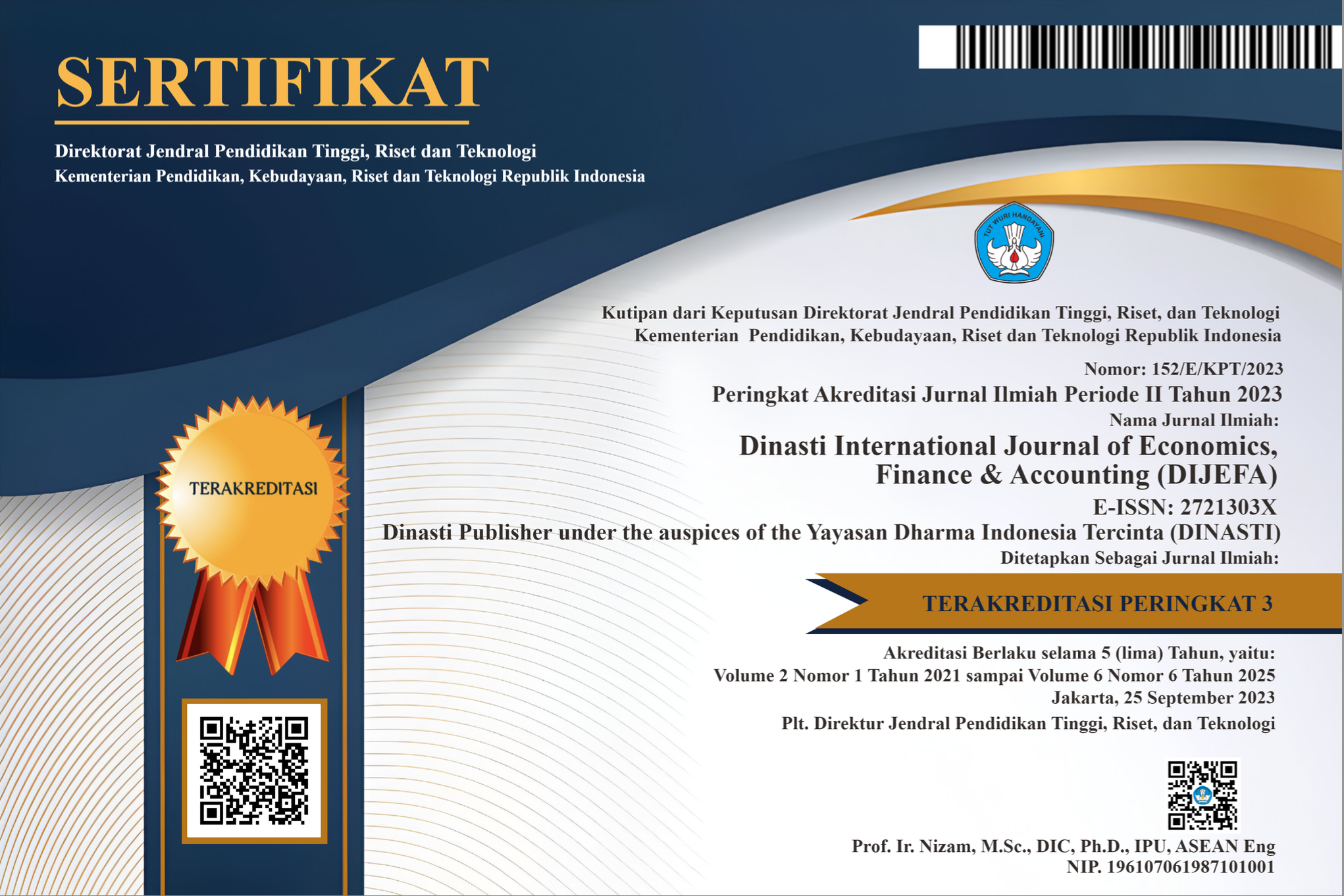Factors Influencing the acceptance of SAKTI Application: Perceived Usefulness, Perceived Ease of Use, and Perceived Risk on State Financial Planning and Budgeting
DOI:
https://doi.org/10.38035/dijefa.v3i5.1444Keywords:
technology acceptance, perceived usefulness, perceived ease of use, perceived risk, SAKTI applicationAbstract
Previous research or relevant research is very important in research or scientific articles. Previous research or relevant research serves to strengthen the theory and phenomena of relationships or influences between variables. This article reviews the factors that influence the acceptance of SAKTI, namely: perceived usefulness, perceived ease of use, and perceived risk, a study of state financial management literature. The purpose of writing this article is to build a hypothesis about the influence of variables that can be used in further research. The results of this literature review article are: 1) perceived usefulness affects the acceptance of SAKTI; 2) perceived ease of use affects the acceptance of SAKTI; and 3) perceived risk affects the acceptance of SAKTI.
References
AlHadid, I., Abu-Taieh, E., Alkhawaldeh, R.S., Khwaldeh, S., Masa’deh, R., Kaabneh, K., & Alrowwad, A. (2022). Predictors for E-Government Adoption of SANAD App Services Integrating UTAUT, TPB, TAM, Trust, and Perceived Risk. International Journal of Environmental Research and Public Health. 19(14), 8281.
Alshurafat, H., Al-Mawali, H. and Al Shbail, M.O. (2022). The influence of technostress on the intention to use blockchain technology: the perspectives of Jordanian auditors, Development and Learning in Organizations, Vol. ahead-of-print No. ahead-of-print. https://doi.org/10.1108/DLO-06-2022-0103
Ardian, Z., Nurliyanti, & Wardana, P. (2021). Analisa Aplikasi Sistem Tata Kelola Keuangan Desa di Kecamatan Darussalam Menggunakan Metode Technology Acceptance Model (TAM). Journal of Informatics and Computer Science, 7 (2), 99 – 105.
Butt, I., Mukerji, B., Shareef, M.A., Ahmed, J.U., & Huda S.S.M.S. (2021). Effect of Trust on e-Shopping Adoption – An Emerging Market Context. Journal of Internet Commerce, DOI: 10.1080/15332861.2021.1927436
Davis, F. D. (1989). Perceived Usefulness, Perceived Ease of Use, and User Acceptance of Information Technology. MIS Quarterly, 13(3), 319–340.
ELKheshin, S.A., & Saleeb, N. (2020). Assessing the adoption of e-government using TAM model: case of Egypt. International Journal of Managing Information Technology (IJMIT), 12 (1). 1-14.
Fadhilatunisa, D., Fakhri., Rosidah, Radhiah, & Jannah, R. (2022). Analisis Aplikasi Pajak (E-Filling Dan E-Billing) Berbasis Technology Acceptance Model (TAM). Jurnal Ilmiah Akuntansi Peradaban, VIII (1), 100 – 119.
Fakhruzzaman, M.N., & Dimitrova, V. (2020). Factors influencing e-government adoption in Indonesia: The importance of Perceived Risk. Jour of Adv Research in Dynamical & Control Systems, 12, Special Issue-06, 125 – 131.
Ha, N.T. (2020). The impact of perceived risk on consumers’ online shopping intention: An integration of TAM and TPB. Management Science Letters, 10 (9), 2029-2036.
Kamal, S.A., Shafiq, M., & Kakria, P. (2020). Investigating acceptance of telemedicine services through an extended technology acceptance model (TAM). Technology in Society, 60, 101212
Kesharwani, A. & Bisht, S.S. 2012. The impact of trust and perceived risk on internet banking adoption in India: An extension of technology acceptance model. International Journal of Bank Marketing, 30 (4), 303-322.
Kuntadi, C., Wahyuni, K.E., & Mansawan, C.M. (2022). Literature review: Faktor-faktor yang Mempengaruhi Kinerja Penganggaran Pada Pemerintah Daerah di Indonesia. Jurnal Ilmu Manajemen Terapan, 3 (6), 561-569.
Lestari, T., Hizazi, A., & Gowon, M. (2020). Analisis Penerimaan Aplikasi Sistem Akuntansi Instansi Berbasis Akrual (SAIBA) dengan Menggunakan Pendekatan Technology Acceptance Model (TAM) Pada Satuan Kerja (Satker) Kementerian Agama Mitra Layanan Kantor Pelayanan Perbendaharaan Negara (KPPN) Jambi. Jurnal Akuntansi dan Keuangan Universitas Jambi, 5(4), 280 – 293.
Madjid, N.C. (2020). Redesain Sistem Perencanaan Penganggaran: Tantangan Mewujudkan Perencanaan dan Penganggaran Yang Efektif Dan Efisien. Simposium Nasional Keuangan Negara 2020, 1075-1095.
Maryati, S., & Siregar, M.I. (2021). Perceptions of Usefulness and Behaviors to Keep Using in the Implementation of Regional Management Information System Applications. Jurnal Ilmiah Akuntansi, 6(2), 281-292.
Prabowo, N.T. (2017). Analisis Sistem Aplikasi Keuangan Tingkat Instansi (SAKTI) dengan Pendekatan Technology Acceptance Model (TAM). Jurnal Perbendaharaan, Keuangan Negara dan Kebijakan Publik, 2 (2), 55-56.
Rakhmawati, H., Sutrisno, T., Rusydi, M.K. (2020). Influence of TAM and UTAUT models of the use of e-filing on tax compliance. International Journal of Research in Business and Social Science, 9(1), 106–111.
Sayekti, F., & Putarta, P. (2016). Penerapan Technology Acceptance Model (TAM) dalam Pengujian Model Penerimaan Sistem Informasi Keuangan Daerah. Jurnal Manajemen Teori dan Terapan, 9.(3), 196 – 209.
Seo, K.H., & Lee, J.H. (2021) The Emergence of Service Robots at Restaurants: Integrating Trust, Perceived Risk, and Satisfaction. Sustainability, 13, 4431.
Syahril, W.N., & Rikumahu, B. (2019). Penggunaan Technology Acceptance Model (TAM) dalam Analisis Minat Perilaku Penggunaan E-Money Pada Mahasiswa Universitas Telkom. Jurnal Mitra Manajemen, 3(2), 201 – 214.
Taherdoost, H. (2017). A review of technology acceptance and adoption models and theories. Procedia Manufacturing, 22, 960–967.
Trinh, H.N., Tran, H.H. & Vuong, D.H.Q. (2020). Determinants of consumers’ intention to use credit card: a perspective of multifaceted perceived risk. Asian Journal of Economics and Banking, 4 (3), 105-120.
Wang, J., Zhao, S., Zhang, W., & Evans, R. (2021). Why people adopt smart transportation services: an integrated model of TAM, trust and perceived risk. Transportation Planning and Technology, 44(6), 629-664.
Wijayanti, A.W., Muluk, M.R.K., Nurpratiwi, R. (2012). Perencanaan Anggaran Berbasis Kinerja di Kabupaten Pasuruan. Wacana. 15 (3), 10-17.
Downloads
Published
How to Cite
Issue
Section
License
Authors who publish their manuscripts in this journal agree to the following conditions:
- The copyright on each article belongs to the author(s).
- The author acknowledges that the Dinasti International Journal of Economics, Finance & Accounting (DIJEFA) has the right to be the first to publish with a Creative Commons Attribution 4.0 International license (Attribution 4.0 International (CC BY 4.0).
- Authors can submit articles separately, arrange for the non-exclusive distribution of manuscripts that have been published in this journal into other versions (e.g., sent to the author's institutional repository, publication into books, etc.), by acknowledging that the manuscript has been published for the first time in the Dinasti International Journal of Economics, Finance & Accounting (DIJEFA).


























































